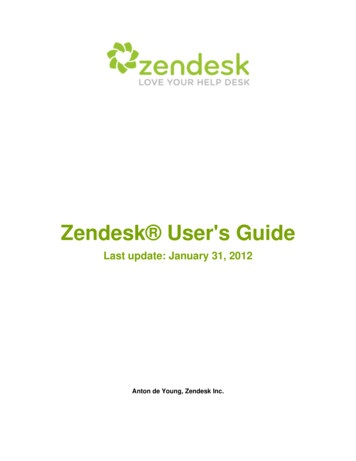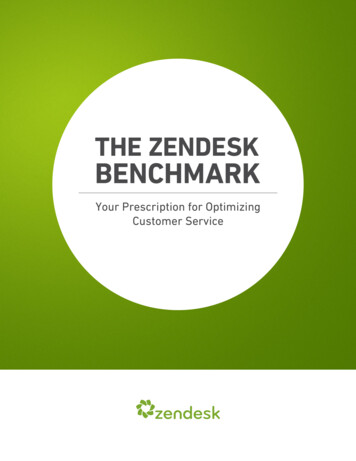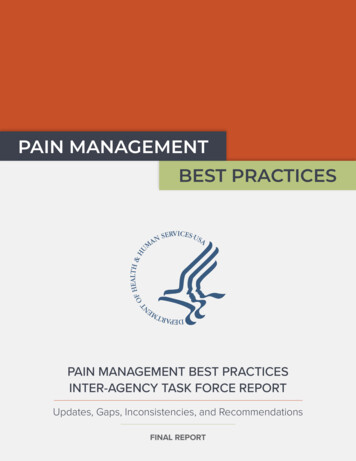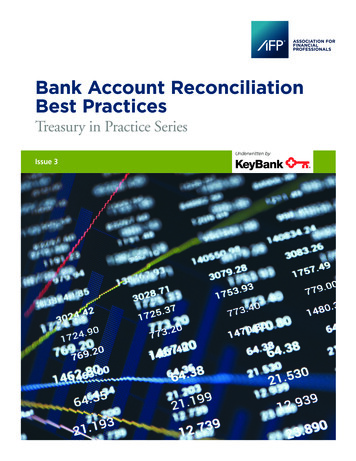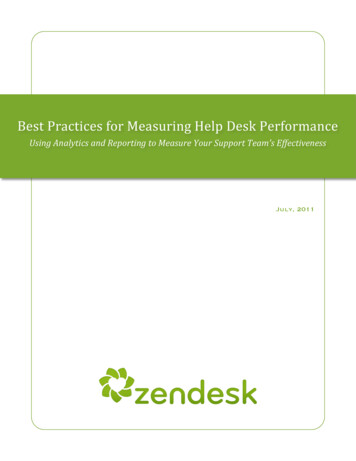
Transcription
fectivenessJuly, 2011
Table of ContentsIntroduction . 3Why smart customers use gooddata and zendesk. 4Measuring key performance indicators (kpis) . 4where do i begin?. 5valuable data through easy-to-read dashboards. 6TicketCreation. 8Backlog. 8SatisfactionScores . 9TicketDistribution . 10OpenIssues. 11Need more? no problem. metrics are easy to customize. 11more than just your help desk: Combine different data sets . 11Conclusion . 13How To Get Started . 13About Zendesk . 132
uctionManaging your company’s customer support should never feel as volatile as predicting the weather. Even if it seems thatyour customers’ behaviors can change on a moment’s notice (and oftentimes do) there are tools that can make yoursupport team always feel on top of any given situation, no matter how bad it gets.Zendesk helps support teams regain control over their help desk, improve workflows and bolster productivity as a result.Powered by GoodData, Zendesk helps take support workflows to the next level by tracking and measuring your helpdesk activity so that the effectiveness of the operations you are putting into place are immediately visible. In fact, this ishow the most sophisticated help desks manage their data.The key is being able to see how your customer’s behavior has changed over time and digging into the treasure trove ofdata that can be found within your support team’s customer interactions. Companies tuned into their support team’sperformance will improve their product, bolster customer satisfaction, and identify issues quickly so corrective actioncan be taken immediately. So how do you share what’s going on within your help desk to your entire organization? Byaccessing and measuring the data that drives your business.Metrics and dashboards are all about measuring the efficiency of your help desk. The more efficient your help desk, thecheaper it is to deliver service. Reporting and analytics help you stay ahead of customers to ensure that they are happy.They help you anticipate if things are going badly before they actually get bad. What you see in your dashboard will tellyou what’s going on with your help desk long before you hear about them from your help desk agents or your customers.Especially for growing support organizations, many of which can be very chaotic, this kind of information is critical.For instance, one of the most important things a support manager should monitor is their backlog. An out-of-controlbacklog can lead to chaotic support, which in turn can lead to unhappy customers. Being able to measure your backlog ishow support managers can always stay ahead of the curve.The graph below shows how specific groups are handling their volume of support requests. Here is where a manager cansee when a specific group or agent is falling behind on its support requests and how that is going to impact backlog.Having a view immediately available that can show when your backlog is growing gives a support manager the ability toaddress and correct any rthatperformanceisimpactingbacklog.Zendesk makes it easy for companies to access the data that drives their business with: On-demand dashboards, reporting and analytics. View pre-built dashboards and reports for support ticketcreation and resolution, agent performance, and top trends.3
BestPracticesforMeasuringHelpDeskPerformance Ad-hoc analysis. Slice and dice your data using all standards and custom ticket fields to track your Zendeskperformance the way you want to see it. Collaborative business intelligence. Collaborate and share custom projects, reports, and results with colleagues skAnalytics and reporting on your support activity can help support managers strategize around growth and have a clearerpicture of staffing needs. It gives companies the ability to dig deeper into its ticket interactions and understand whatfactors could cause spikes in its volume of support requests. Companies are then able to create a plan of attack to meetthe needs of their short and long-term. This is how companies like Groupon, which has resolved more than 4 milliontickets since using Zendesk, are able to scale their support in relation to its tremendous growth. These are the tools thatempower a company to deliver the kind of support that organizations such as Groupon ng Zendesk, managers can create dashboards that enable them keep a close eye on the top five or six KeyPerformance Indicators (KPIs) most important to their organization.For instance, these KPIs might include: Agents must answer X # of tickets Agents or departments must have a certain satisfaction score Only certain number of tickets should be escalated These dashboards let managers take a step back once a week to see how their help desk is performing without having tospend the oft requisite and weekly five to ten hours of management reporting because Zendesk does it for them, out ofthe box.Another metric large-volume support companies, such as Twitter and Rackspace, are interested in is tickets by group.They want to know which group is taking which volume of tickets and how many tickets get passed between groups.The reason they are particularly interested in these two metrics is because when tickets are passed between groups, it getsmore expensive. This is important information to understand. No one wants to get blindsided by escalating costs in theirsupport.The most efficient help desks are also very interested in how their one-touch tickets. These are tickets that are solvedwith one reply. The more tickets that can be solved with one reply, the more efficient and productive your help desk. Ifyour team doesn’t seem to be solving as many one-touch tickets as it should be, this is when you can start to create astrategy that will improve the number of support requests that are resolved with one reply. For instance, with Zendesk,solving tickets with one reply is very easy thanks to macros, pre-determined responses to frequently asked questions.Macros offer organizations huge savings, because they don’t require any additional people.And companies such as Xobni, which manage outsourced support (with third party agents logging into their Zendesk),don’t have to create partner reporting because that comes out of the box as well. It’s not only a way to save time; it’s away to share valuable information across your organization.With Zendesk’s GoodData integration, anyone who uses Zendesk has access to the best practices of the thousands ofhelp desks that are using it and the shared wisdom of the entire community. Regardless of your size, you get the samemetrics that Rackspace, Twitter, Groupon, New Zealand Post, and Hulu, among others, use to shape their supportstrategy.4
oIBegin?The hardest thing for most businesses is to know exactly what they should begin measuring.Zendesk solves this issue by providing companies with the most important metrics every business should use to measurethe effectiveness of their support with pre-built dashboards that represent the best practices of hundreds of Zendeskcustomers.For instance, the overview tab is mission control. This is where you can see at a glance a help desk’s most commonmetrics: New ticketsTickets solvedPercent of tickets solvedAverage First-Time ReplyAverage Requester WaitFirst ResolutionFull lpdesk’smostcommonmetrics.What these metrics help support managers do is understand their support workload their team is dealing with at any time.It also allows them to see how their support is trending over time and whether they are above or below the average.Seeing these trends empowers managers to create a support strategy that allows them to distribute their resourcesproperly, understand their staffing needs, and their trouble spots.Looking at that information in the larger context of how things are trending over time gives support managers the powerto know when their team is delivering seamless report and when they are not, and whether their backlog is growing orshrinking.ValuableDataThroughEasy- ‐to- ‐ReadDashboardsFor many organizations, dashboards offer a first-ever visualization of their help desk’s aggregated performance. This iswhere managers can break down the data and point specifically to the reasons for why their response time is going up.5
BestPracticesforMeasuringHelpDeskPerformanceThis is how they can see if there may have been an incident that was never closed.With Zendesk’s GoodData integration, there are six tabs that immediately offer users a picture of what’s happening. Youdon’t have to be a statistician, you don’t have to be a SQL person, or use Excel pivot tables to get this. It’s all out of thebox, immediately ready to go.Let’s go through a few of these wmanysupportrequestswerecreated.6
ile, the graph below illustrates through which channels agents are fielding support. We can see that online webform and email are the most popular ways for submitting ssupportrequestsaresent.This kind of view enables help desk managers to assess their company’s preferred channels. From there they can ask: Dowe have adequate support to handle a large volume of tickets via web form and email? Is there another channel we’d liketo start encouraging our customers to use instead?Managers can also look at new tickets by group and month. This is important because it allows you to see which groupsare fielding the largest volume of tickets, and from there you can determine whether those groups have the capacity tocontinue to field this volume. With this information, you can then draw correlations between ticket volume and othermetrics, such as customer satisfaction or ticket resolution. This is how a support manager can bolster its support team’sefficiency. You can begin to find the weak spots in your support team and adjust your support strategy as necessary. Thisis the information support managers need to create an informed capacity planning; it will show where there are holes inyour support team and where it might be over-staffed.7
stscreatedbyspecificgroups.Monthly and time of day views of your company’s support activity allow you to see if there are any notable trends involume, which can help you understand the seasonality of your support workload. For example, if your company alwayslaunches products or feature updates on Thursdays, and Thursday is already a high-volume support activity day for yourcompany, you know to increase your staffing needs or change your launch dates.BacklogOne of the most important things help desks care about care about is their backlog. If more requests are coming in thanare solved every week, it means you’re building a backlog. The table below shows which groups within a support teamare grabbing and solving support requests. What this reveals to a manager is whether their help desk is overwhelmed bysupport requests and whether there are enough resources to service customers in a timely wingbacklog.And they can use that information to plan ahead. The table below illustrates this company’s predicted backlog. Lookslike the development team is falling behind. Given its weekly average for solving support requests, we can see that it’sgoing to take approximately four weeks to resolve all of the support requests in its queue. Armed with that information,managers can react accordingly and see what can be done to help get the development team up to speed.8
givenweek.SatisfactionScoresThe definitive business metric a company can capture is whether its customers are satisfied. Zendesk makes it easy tocapture customer satisfaction ratings automatically when tickets are solved. Once the evaluation has been received,comprehensive metrics are surfaced through out-of-the-box reports and dashboards. Companies can then set upworkflows that immediately respond to negative ratings.Customer satisfaction dashboards gives managers the power drill down and figure out whether your customers aresatisfied with the way their issues are being nscores.The dashboard can aggregate satisfaction levels by agent, enabling agents to spot problem areas immediately and fixthem or help a company strategically train agents and assess strengths and weaknesses.9
agent.This is how support managers can find out which agents might be ready to take on more challenging requests and whichmight need to stay put or require additional training and resources. Look at agent performance can also alert managers asto whether there is a company-wide problem regarding your product or service. If everyone is performing low, it’s a redflag that something much bigger is going on.TicketDistributionTickets refer to any and all support requests entered into Zendesk. When you reply or resolve a support request, you arereplying or resolving what we call a ticket.An important thing for support managers to look at is how those “tickets” or support requests are distributed. Forinstance, this is where you can determine if there is any correlation between satisfaction scores and low first-time repliesto support requests. It’s how a support manager can determine if they have enough agents to manage their ticket volumeand keep backlogs to a minimum.Monitoring your ticket distribution can alert you to a problem with your product or service. If you see sudden spikes inthe amount of support requests you are getting, a manager can investigate right away and see if there is an underlyingissue that needs to be addressed company-wide. Or what about your premium customers? Everyone wants to make surethey are happy with the level of support they are receiving. A ticket distribution report can see if you have a specificcustomer filing a higher than average number of tickets and investigate.Ticket distribution reports can also show how your company is doing in regards to “one-touch” tickets. That is thenumber of support requests that can be answered with on one-reply. For most companies, macros, or pre-configuredanswers to resolve frequently asked questions are instrumental to delivering one-touch tickets. Beyond being able to seehow features such as macros help bolster efficiency and productivity, it can also help support managers devise a largerstrategy on how their help desk is using macros. This is just one more way of understanding what’s happeninghistorically within your help desk, especially as it relates to your volume of support requests and the efficiency withwhich you can manage those requests.10
eresolvedwithonereply.OpenIssuesSupport teams harness a tremendous amount of valuable information that is never shared. Instead, it goes away with thesolved support request. Information that could be used to help managers detect trouble spots is lost forever. Our “openissues” dashboard solves that problem. For instance, if you have customers who continually complain they’ve beenbounced around to different agents, you can see which support requests have been opened multiple times, which havebeen escalated through different group stations, and which were tagged urgent or high priority have continued to gounsolved.From this dashboard, support managers can also see if an organization’s top ticket trends can help a managerimmediately see where they need to allocate the most resources, and can also convey a larger message to the rest of yourorganization. Support is an island in a lot of organizations, which is unfortunate, since your help desk is often thegreatest indicator of your company’s health and the happiness of your customers. Zendesk’s GoodData integration helpscompanies be customer support-oriented in an efficient way that doesn’t bankrupt or bog down any part of yourcompany’s operations.Meanwhile, being able to look at your organization’s volume of active tickets shows you “chatty” tickets that eitherrepresent inefficiencies in your help desk or potentially underlying problems with your product or service that are hard toresolve.These views of your support activity and workload provide better visibility into your support team’s workflows. Younow know why certain incidents occur and can devise a strategy to react accordingly. If reoccurring support issues aretied to a problem in your product or service, you now have a tangible way of sharing that information with the rest ofyour organization. This kind of visibility makes it easier for managers to plan for the future and prevents ytoCustomizeMany organizations can use the GoodData for Zendesk integration without ever having to change a thing. But when it isnecessary to change things to fit your company’s needs, it’s easy to do. In the same way that Zendesk has made it easy touse its features, such as creating a macro, rule, or adding agents, GoodData has made it easy to change reports. Forinstance, if you want to measure your backlog in a different way, you can do that. If you want to exclude certain groupsor certain submission methods from what you track, you can easily do that. If the cadence of your help desk is minutes asopposed to hours, you can make those changes in just a few minutes. You’re not locked into a particular way of doingthings.11
anJustYourHelpDeskDataThe power of metrics is even bigger when you look at more than just your help desk data.With Zendesk, organizations can mash up different data sets that empower them to dig even deeper into what makes theirsupport workflows tick unite it with numbers that matter across your entire organization. For instance, you can compareyour supp
Zendesk helps support teams regain control over their help desk, improve workflows and bolster productivity as a result. Powered by GoodData, Zendesk helps take support workflows to the next level by tracking and measuring your help desk activity so that the effectiveness of the operations you are putting into place are immediately visible.File Size: 2MBPage Count: 13



